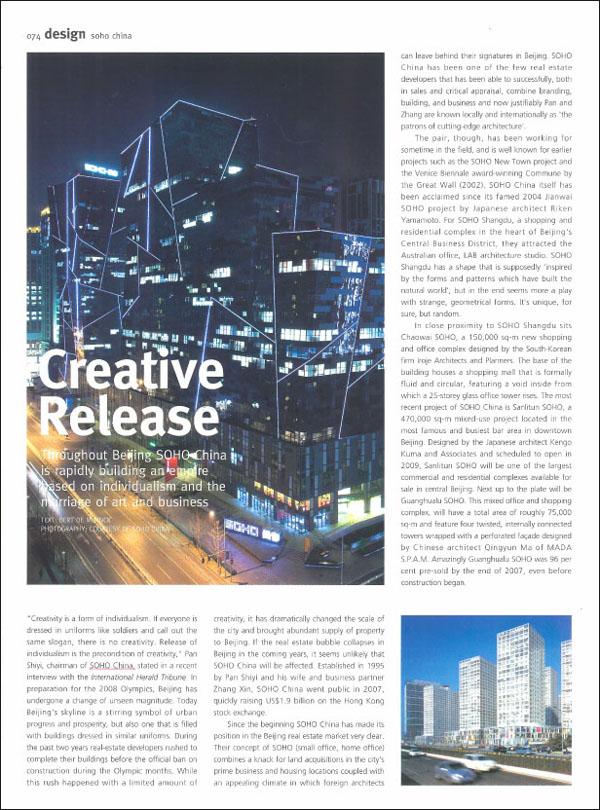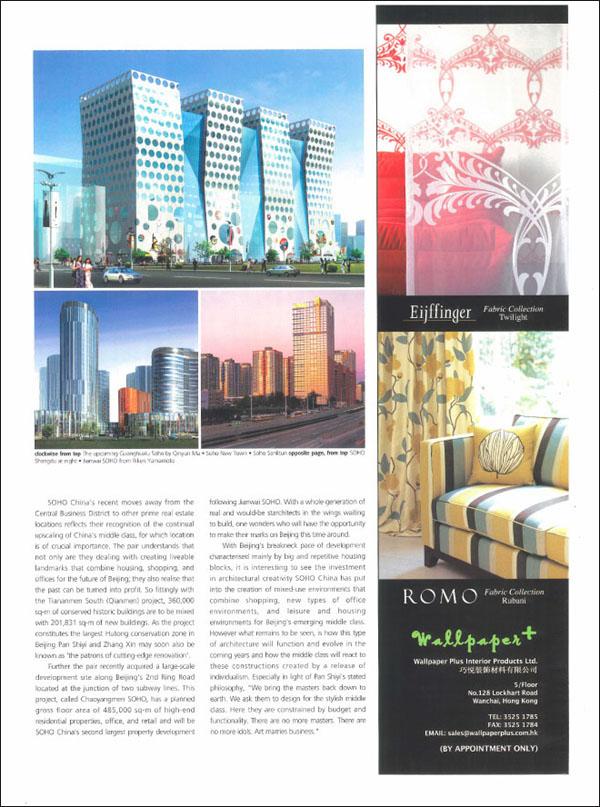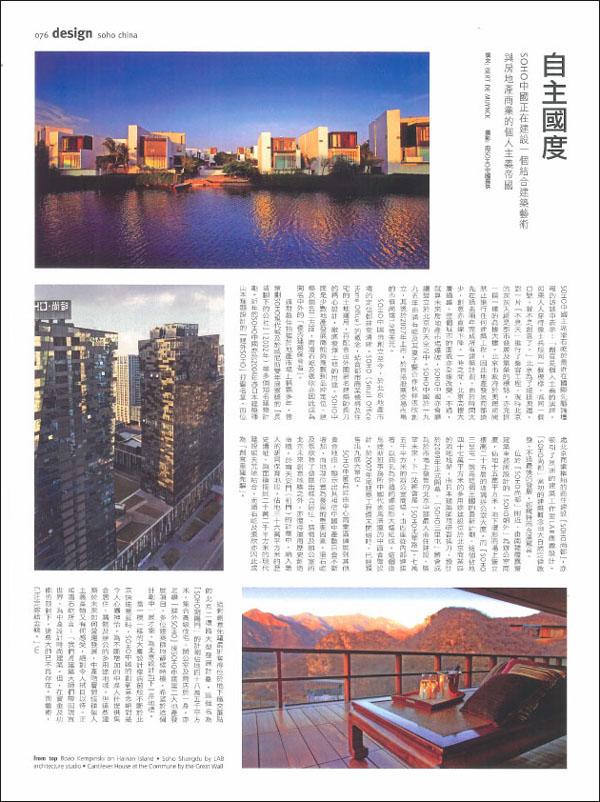


6) words from the editor
The question of what will happen to Beijing Now that the Olympics are over is on everyone s minds. Scores of column inches and mountains of speculation have already been produced at the time of writing, with the Closing Ceremony having taken place barely a month ago and the paralympics just finished.
Rather than add to the current rancor speculation what will happen - which, in hindsight, is doomed to be wrong - we choose to focus firmly on the overlooked events of the recent past that portend the shape of the future of the capital city. So while we look at a few recently opened boutique hotels, whose future if at best, uncertain - we also are pleased to feature the efforts of SOHO China and its ongoing commitment to service business and an emerging, yet powerful, new middle class, rather than the one-off jewels for the nation s coming-out party.
Significantly, we also opt to focus on conservation and adaptive re-use projects such as Alan Chan s The Barn, and smaller scale projects like Ministry of Design s house at the Commune by the Great Wall. We have interviews with young artists and designers based in Beijing including Chan Studio, Fake Design, and Resonance that represent a new generation that will be the true future of the city in the post-Olympic years.
While we may not be offering wild projections of vast future changes to an already, perhaps too chaotic city. we hope you will find this issue, a roadmap to a not-too-distant future.
"Creativity is a form of individualism. If everyone is dressed in uniforms like soldiers and call out the same slogan, there is no creativity. Release of individualism is the precondition of creativity," Pan Shiyi, chairman of SOHO China, stated in a recent interview with the International Herald Tribune.
In Preparation for the 2008 Olympics, Beijing has undergone a change of unseen magnitude. Today Beijing s skyline is a stirring symbol of urban progress and prosperity, but also one that is filled with buildings dressed in similar uniforms. During the past two years real-estate developers rushed to Complete their buildings before the official ban on construction during the Olympic months.
While This rush happened with a limited amount of creativity, it has dramatically changed the scale of The city and brought abundant supply of property to Beijing. If the real estate bubble collapses in Beijing in the coming years, it seems unlikely that SOHO China will be affected. Established in 1995 by Pan Shiyi and his wife and business partner Zhang Xin, SOHO China went public in 2007, quickly raising US$1.
9 billion on the Hong Kong stock exchange.
Since the beginning SOHO China has made its position in the Beijing real estate market very clear. Their concept of SOHO (small office, home office) combines a knack for land acquisitions in the city s prime business and housing locations coupled with an appealing climate in which foreign architects can leave behind their signatures in Beijing.
SOHO China has been one of the few real estate developers that has been able to successfully, both in sales and critical appraisal, combine branding, building, and business and now justifiably Pan and Zhang are known locally and internationally as the patrons of cutting-edge architecture .
The pair, though, has been working for sometime in the field, and is well known for earlier projects such as the SOHO New Town project and the Venice Biennale award-winning Commune by the Great Wall (2002). SOHO China itself has been acclaimed since its famed 2004 Jianwai SOHO project by Japanese architect Riken Yamamoto.
For SOHO Shangdu, a shopping and residential complex in the heart of Beijing s Central Business District, they attracted the Australian office, LAB architecture studio. SOHO Shangdu has a shape that is supposedly inspired by the forms and patterns which have built the natural world , but in the end seems more a play with strange, geometrical forms.
It s unique, for sure, but random.
and office complex designed by the South-Korean firm lroje Architects and Planners. The base of the building houses a shopping mall that is formally fluid and circular, featuring a void inside from which a 25-storey glass office tower rises. The most recent project of SOHO China is Sanlitun SOHO, a 470,000 sq-m mixed-use project located in the most famous and busiest bar area in downtown Beijing.
Designed by the Japanese architect Kengo Kuma and Associates and scheduled to open in 2009, Sanlitun SOHO will be one of the largest commercial and residential complexes available for sale in central Beijing. Next up to the plate will be Guanghualu SOHO. This mixed office and shopping complex, will have a total area of roughly 75,000 sq-m and feature four twisted, internally connected towers wrapped with a perforated facade designed by Chinese architect Qingyun Ma of MADA S.
P.A.M. Amazingly Guanghualu SOHO was 96 per cent pre-sold by the end of 2007, even before construction began.
SOHO China s recent moves away from the Central Business District to other prime real estate locations reflects their recognition of the continual upscaling of China s middle class, for which location is of crucial importance. The pair understands that not only are they dealing with creating liveable landmarks that combine housing, shopping, and offices for the future of Beijing; they also realise that the past can be turned into profit.
So fittingly with the Tiananmen South (Qianmen) project, 360,000 sq-m of conserved historic buildings are to be mixed with 201,831 sq-m of new buildings. As the project constitutes the largest Hutong conservation zone in Beijing Pan Shiyi and Zhang Xin may soon also be known as the patrons of cutting-edge renovation1.
With Beijing s breakneck pace of development characterised mainly by big and repetitive housing blocks, it is interesting to see the investment in architectural creativity SOHO China has put into the creation of mixed-use environments that combine shopping, new types of office environments, and leisure and housing environments for Beijing s emerging middle class.
However what remains to be seen, is how this type of architecture will function and evolve in the coming years and how the middle class will react to these constructions created by a release of individualism. Especially in light of Pan Shiyi s stated philosophy, "We bring the masters back down to earth.
We ask them to design for the stylish middle class. Here they are constrained by budget and functionality. There are no more masters. There are no more idols. Art marries business."
Related News
Photos
More>>trade
market
finance
- Global Times - SOHO goes to Sanlitun
- Le Point - La femme qui change la pierre en or
- China International Business - SOHO China CEO Zhang Xin:On real estate bubbles
- SOHO China - SOHO Nexus Centre First Day Sales Reach RMB2.09 Billion
- SOHO China - The Exchange-SOHO Sales Reached RMB1.3 Billion at First Day Launch





